#National Naval Aviation Museum
Explore tagged Tumblr posts
Text
















An act of the U.S. Congress creates the United States Coast Guard as a branch of the United States Armed Forces on January 28, 1915.
#act of the U.S. Congress#United States Coast Guard#28 January 1915#U.S. Coast Guard Barque Eagle#Golden Gate Bridge#San Francisco#Architecture#Eureka#California#US Virgin Islands#Charlotte Amalie#Point Cabrillo Light Station#Port Angeles#lighthouse#Pigeon Point Light Station#Washington#National Naval Aviation Museum#Pensacola#Florida#Point Arena Lighthouse#summer 2017#travel#110th anniversary#US history#Newfoudland#Canada#Vancouver#original photography#vacation#tourist attraction
3 notes
·
View notes
Photo

When this SR-71 Blackbird was delivered to the National Air and Space Museum, it set a speed record for a flight from Los Angeles to Washington, D.C., at 1:04:20.
#Blackbird#Boeing Aviation Hangar#Chantilly#Convention#Lockheed#MediaFest22#N3N-3 Trainer#National Air and Space Museum#Naval Aircraft Factory#Pentax K-3#SPJ#SR-71#Seaplane#Smithsonian Institution#Society of Professional Journalists#Steven F. Udvar-Hazy Center#Vacation#Virginia
1 note
·
View note
Text


HORRIFIC, DISTURBING VISIONS OF WAR INCOMING -- WAR IS A BLACK HOLE TO AVOID.
PIC INFO: Bomb bay camera in a TBF-1 Avenger from USS Essex captures the moment of bomb release over the Pasig River in downtown Manila, Luzon, Philippines, 14 Nov 1944. Attack was on the dock area 2,000 yards further ahead.
Photographer: Unknown.
Source: United States Navy National Museum of Naval Aviation.
Topic: Philippines Campaign, Phase 1, the Leyte Campaign.
Source: https://m.ww2db.com/image.php?image_id=24254 & Pinterest.
#War photography#War history#WWII#1944#War is Hell#Hell is War#Aerial Bombardment#The Philippines Campaign#TBF-1 Avenger#USS Essex#Pasig River Manila#Bombings#Aerial Bombing#World War II#World War 2#WW2#Forties#Pacific War#Philippines#40s#The Leyte Campaign 1944#Luzon Philippines#Luzon#Manila#Pacific Theater of War#1940s#The Philippines#Philippines Campaign WWII#United States Navy National Museum of Naval Aviation
0 notes
Text

National Naval Aviation Museum - Naval Air Station Pensacola, Florida
The National Naval Aviation Museum is the world’s largest Naval Aviation museum and one of the most-visited museums in the state of Florida. It features more than 150 beautifully restored aircraft representing Navy, Marine Corps, and Coast Guard Aviation. These historic and one-of-a-kind aircraft are displayed both inside the Museum’s over 350,000 square feet of exhibit space and outside on its 37-acre grounds.
#USN#Navy#Naval Aviation Museum#Aviation#Naval Aviation#Aviation Museum#F-14#Tomcat#American Flag#NAS Pensacola#Aerospace#Military
124 notes
·
View notes
Text
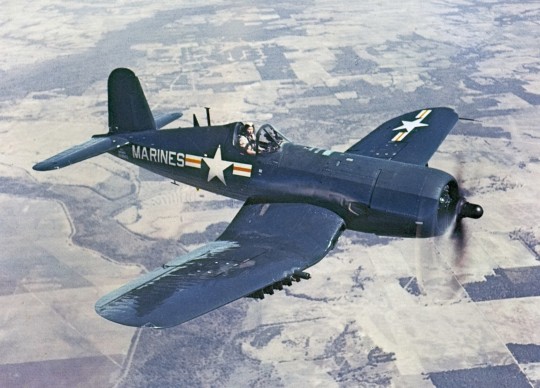
Chance Vought AU-1 Corsair de l'US Marine Corps – 1952
©United States Navy National Museum of Naval Aviation - 1986.145.002
#après-guerre#after war#corps des marines#us marine corps#aviation militaire#military aviation#avion de chasse#chasseur#fighter#chasseur-bombardier#fighter-bomber#chance vought f4u corsair#f4u corsair#corsair#au-1 corsair#1952
99 notes
·
View notes
Text
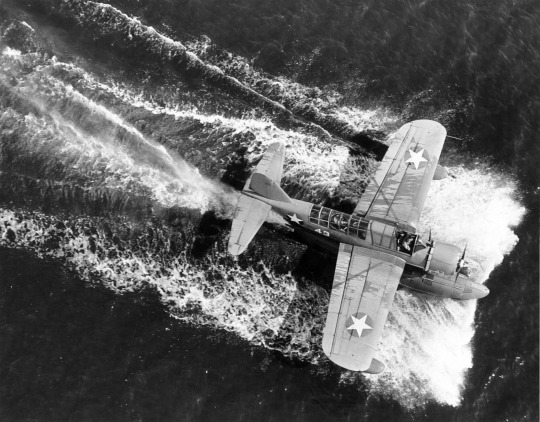

Vought OS2U Kingfisher taxiing after making a water landing near Naval Air Station Jacksonville, Florida.
Date: March 1943
United States Navy National Museum of Naval Aviation: link, link
#Vought OS2U Kingfisher#OS2U#Floatplane#Observation Plane#Seaplane#Spotter Plane#Aircraft#Airplane#United States Navy#U.S. Navy#US Navy#USN#Navy#World War II#World War 2#WWII#WW2#WWII History#History#Military History#Naval Air Station Jacksonville#Jacksonville#Florida#March#1943#my post
119 notes
·
View notes
Text

F-15D Eagle Spotted with Unusual Infrared Measurement Pod
Stefano D'Urso
F-15D IR pod
The pod appears to be previously unseen but closely resembles the Airborne Turret Infrared Measurement System III (ATIMS III), which is used to perform airborne IR signature measurements.
A U.S. Air Force F-15D has been recently spotted flying in a very unusual configuration, usually seen only for very specific tests. In fact, the aircraft was carrying on its station #2, instead of the usual external fuel tank, what appears to be a large InfraRed pod.
The pod appears to be previously unseen but closely resembles the Airborne Turret Infrared Measurement System III (ATIMS III), which is used to perform airborne IR signature measurements.The IR-measuring podsATIMS IIIThe other pods
The photos, kindly shared with us by aviation photographer @arizona_planespotter, shows the aircraft, sporting the markings of the 144th Fighter Wing from Fresno Air National Guard Base, California, taking off from Morris ANGB in Tucson, Arizona, together with an F-15C. The two fighters apparently took part in a mission with local F-16s.
Upon closer inspection, the single-seater Eagle appears to be aircraft 83-0026, which sports on its tail the markings of the Air National Guard/Air Force Reserve Test Center. The unit is based at Morris ANGB and primarily supports F-16 operational flight program (OFP) testing, although it is tasked also with testing of other aircraft.
The large pod, which is half the length of the F-15’s external fuel tank, appears to be equipped with a ball sensor turret in the front. While some argued this might be a prototype of a directed energy weapon, the most plausible identification is an infrared measurement pod which is usually carried by twin-seater F-15Ds.

The F-15D with the unknown pod takes off from Morris ANGB. (Image credit: @arizona_planespotter)
In fact, the OT- and ET-marked aircraft are able to employ a range of highly specialized pods to accurately measure infrared signatures while airborne. This capability is usually employed during the development of IR seekers or sensors, as well as IR countermeasures.
We reviewed the available imagery of the known pod, but we were not able to find a 100% match, given the nature of these pods. While the unknown pod shares similarities with the SARIS and SATIRS pods, the closest match is the ATIMS III pod, although there are some differences.
The overall shape and dimensions of the two pods appear to be the same, however there are some differences in the sensor turret and some fairings on the body of the pod. We should note that the most recent info about the pod dates back to 2020, so we cannot exclude the possibility of a newer variant.
The IR-measuring pods
According to The War Zone, which published in 2020 an in-depth report about the unusual pods, both the Air Force and Navy use these specialized pods. While the Navy’s pods, usually seen on twin-seater F/A-18s, are also used by F-15Ds, the Air Force’s ones appear to be exclusive to the F-15D.
The choice of the F/A-18 and F-15 is due to their ability to carry large and heavy loads. The latter has been particularly used throughout the years to carry outsized loads during testing and operational missions.
At the time of the 2020 report, Naval Air Systems Command (NAVAIR) maintained two podded systems, the Airborne Turret Infrared Measurement System III (ATIMS III) and the Threat Infrared Generic Emulation Radiometer (TIGER). Four more pods are available for the Air Force, with 96th Test Wing employing the Beam Approach Seeker Evaluation System (BASES), the Calibrated IR/visible/UV Ground and Airborne Radiometric Spectrometer (CIGARS), the Supersonic Airborne Tri-Gimbal Infrared System (SATIRS), and the Spectral/Spatial Airborne Radiometric Infrared System (SARIS).

The ATIMS III pod (top) and the unknown pod (bottom). (Image credit: The Aviationist using photos by Brian Lockett/Goleta Air And Space Museum and @arizona_planespotter)
ATIMS III
ATIMS III has been defined in 2020 as the latest generation of a system that dates back to at least the 1970s. The system was originally integrated aboard the A-3 Skywarrior, before being later developed into a podded variant, the ATIMS II, employed by the F-4 Phantom II.
The system, which allowed greater flexibility and more ease of use compared to the original one, had an articulating turret with various cameras and sensors installed that a single operator could point at the desired target. Today’s ATIMS III was acquired in the 1980s and offers even greater capability.
The pod’s sensor turret can hold up to four different infrared seeker types at once. The system is also equipped with one middle wavelength infrared (MWIR) imager and three visual spectrum video cameras, as well as a laser rangefinder. This allows to collect a multitude of data from multiple sensors at the same time.
The available photos show that the pod can be installed either with the turret facing forward or facing backwards, depending on the test’s requirements. TWZ reported that the pod’s design is highly modular and adaptable and features a digital data recording system.
The report included a mention of a statement from Ampex Data Systems Corporation which provided solid-state recorders to capture the full spectrum of infrared data measured by the pod as part of an upgrade program. According to the statement, which uses the alternate Airborne Infrared Countermeasure Evaluation System (AICES) name, the pod can possibly transmit collected data to the ground via datalink.

The F-15s returning to Morris ANGB. (Image credit: @arizona_planespotter)
The other pods
The second pod operated by the Navy is the Threat Infrared Generic Emulation Radiometer (TIGER), which is designed for more general aerial infrared signature measurement of fixed-wing and rotary-wing aircraft, as well as decoy flares. TIGER carries three MWIR cameras and a long-wavelength infrared (LWIR) camera, in addition to a separate infrared tracking camera and an MWIR spectrometer, along with three visual spectrum video cameras and a laser rangefinder.
TWZ reported that the spectrometer allows to verify how the infrared radiation from the test subjects interacts with the surrounding environment, enabling the pod to gather data on an object’s temperature, how that heat is distributed and how the resulting infrared signature might fluctuate under different environmental conditions and at extended distances.
Similarly to ATIMS III, the pod can be carried with the turret either facing forward or backwards. TIGER is usually seen on F/A-18s, however there are instances when it was employed by F-15s, sometimes together with ATIMS III in the same flight.
Another pod is the Spectral/Spatial Airborne Radiometric Infrared System (SARIS), focused on infrared spectroscopy. More specifically, a scientific article published online mentions that SARIS uses an Imaging Fourier Transform Spectrometer (IFTS), which permits the determination of the surface temperatures of distant objects and, combined with imaging capability, allows rapid temperature mapping.
The document says that SARIS, first delivered to Eglin AFB in 2003, is used to characterize infrared targets, such as aircraft, missiles and flares, from the air. The pod is equipped with a co-registered, high-definition infrared camera and two internal blackbody sources for performing in-flight radio-metric calibration.
There are limited freely available details about the BASES, CIGARS, and SATIRS pods, but they are understood to have general capabilities very similar to those of ATIMS III and TIGER.
Thanks again to @arizona_planespotter for the photos he sent us! Make sure to follow him on Instagram for more!
@The Aviationist.com
22 notes
·
View notes
Text

An F2H-2 Banshee of Fighter Squadron (VF) 44 pictured on the ground at Naval Air Station (NAS) Oakland, California, on February 13, 1955, fifty-nine years ago today. By National Naval Aviation Museum
16 notes
·
View notes
Text




Evolution of high-altitude flight suits into the first space suits.
National Naval Aviation Museum, Pensacola, FL
#space#space suit#aviation#rockets#rocket science#astronaut#space race#cold war era#cold war aircraft#nasa
12 notes
·
View notes
Text
F-14 FUN FACT OF THE DAY #68
On March 3, 2007, an F-14D(R) Super Tomcat was delivered to the Fort Worth Aviation Museum in a Lockheed C-5A Galaxy to the Fort Worth Aviation Museum. On loan from the National Naval Aviation Museum (NNAM) in Pensacola, Florida, this aircraft holds the title of being the longest serving F-14 Tomcat in the Navy having delivered on July 16, 1975.
While F-14 BuNo. 159600 was participating in the Tomcat’s final cruise a bulkhead would blow out during routine maintenance and the aircraft would spend most of the next few months in the hangar earning the nickname “Christine” after the Stephen King thriller.
Read more about Christine here!

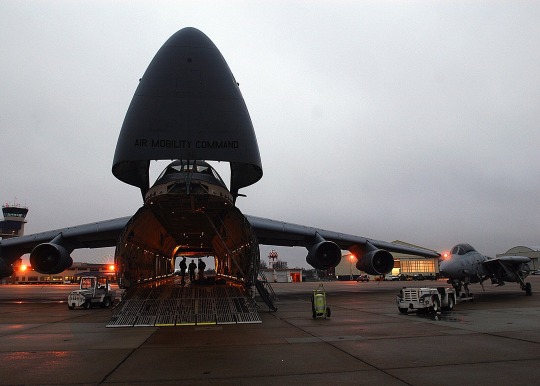

#fffotd#f-14 fun fact of the day#f-14 tomcat#f-14#aviation#fighter jet#F-14D(R)#<- that means she was delivered an A but was retrofitted into a D-variant#top gun#Christine#we love us a hangar queen
38 notes
·
View notes
Text
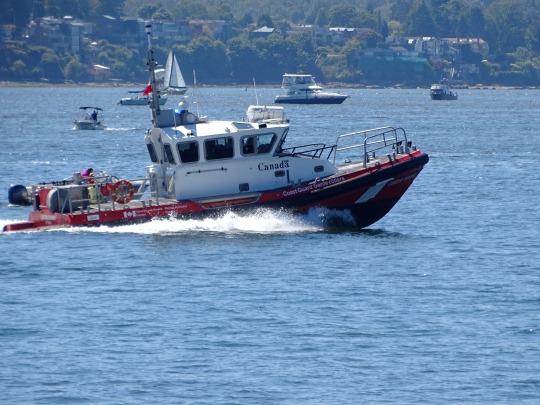
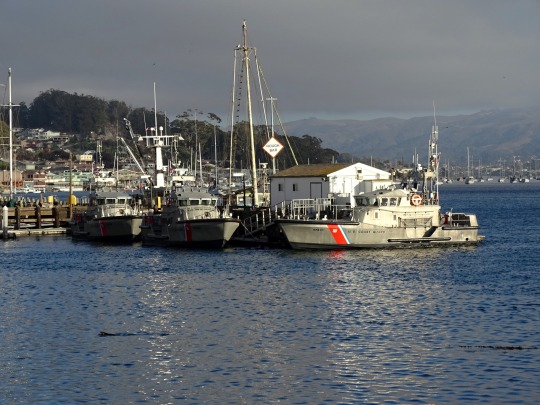
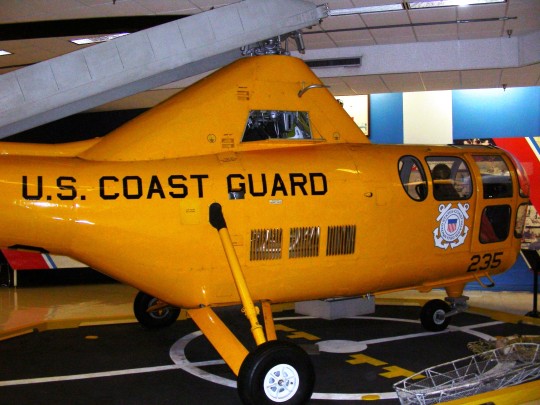
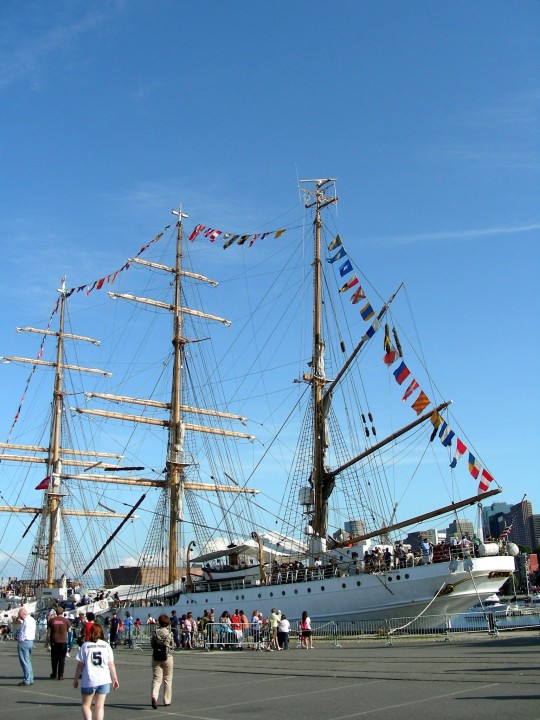
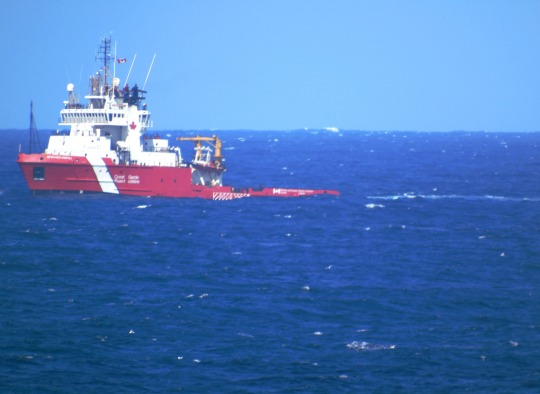


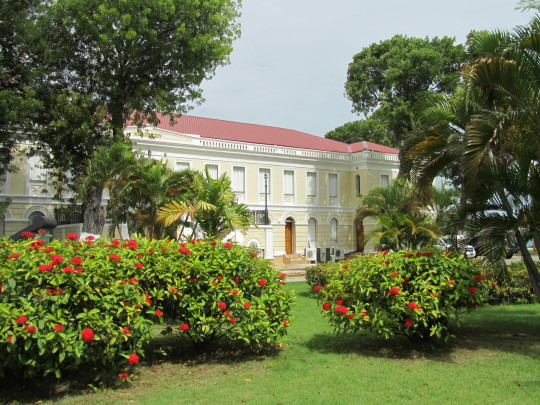
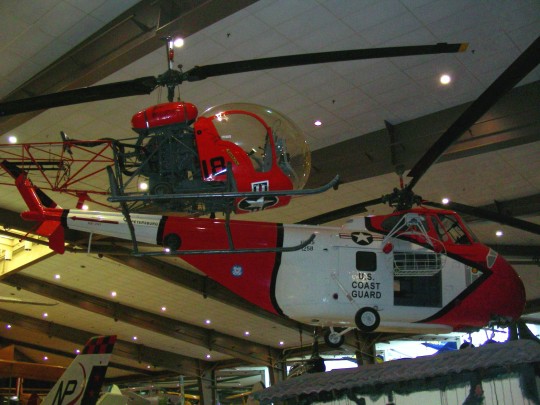

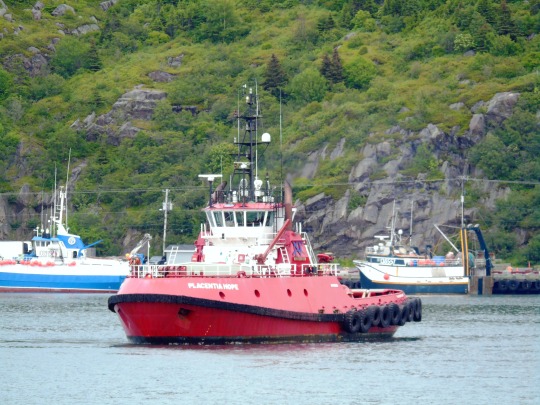
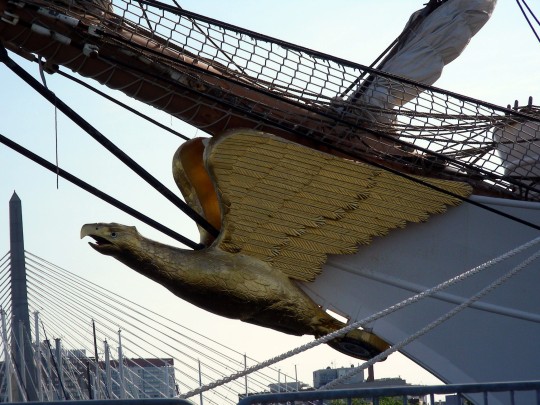

U.S. Coast Guard Day
U.S. Coast Guard Day honors the United States Coast Guard, the military branch that protects the waters and shorelines of the United States. It is celebrated on the anniversary of the founding of the Revenue Marine, the forerunner of the Coast Guard. On August 4, 1790, the United States Congress created the Revenue Marine and authorized the construction of 10 revenue cutters to be used to enforce U.S. tariff laws—to stop illegal smuggling and collect revenue on incoming goods. The Revenue Marine was housed in the Department of Treasury and thus directed by Secretary of Treasury Alexander Hamilton.
The Revenue Marine's name was later changed to the Revenue Cutter Service. Then, in 1915, the Revenue Cutter Service was combined with the United States Life-Saving Service to form the United States Coast Guard. This created a single maritime service, bringing together one devoted to enforcing maritime laws and one dedicated to saving lives. The United States Lighthouse Service became part of the Coast Guard in 1939, and the Bureau of Marine Inspection and Navigation became part of it in 1946. In 1967, the Coast Guard was transferred from the Department of Treasury to the newly-created Department of Transportation. Similarly, it was transferred to the Department of Homeland Security in 2003.
U.S. Coast Guard Day has been marked in some form since at least 1928. Presidents have proclaimed August 4th as "Coast Guard Day." Harry Truman did so in 1948, and Ronald Reagan did so in 1984 after being requested to do so by Congress. In large part, U.S. Coast Guard Day is an internal celebration by Coast Guard personnel and their families, but others join in honoring Coast Guard members as well. Coast Guard units often organize picnics and informal sports competitions, where they celebrate with family and friends. The American flag is typically flown on the day, particularly by those who have family members in the Coast Guard. Grand Haven, Michigan, known as Coast Guard City, USA, holds the annual Coast Guard Festival each year around August 4th.
The Coast Guard defines itself as "the principal Federal agency responsible for maritime safety, security, and environmental stewardship in U.S. ports and inland waterways, along more than 95,000 miles of U.S. coastline, throughout the 4.5 million square miles of U.S. Exclusive Economic Zone (EEZ), and on the high seas." It has active duty, reserve, and civilian employees, and there also is a Coast Guard Auxiliary. It is divided into two area commands, the Pacific Area and the Atlantic Area, and these are divided into nine district commands. Many Coast Guard stations are located in the districts. The Coast Guard fleet consists of cutters, boats, and fixed and rotary-wing aircraft. Today this branch of the military and its members are honored with U.S. Coast Guard Day!
How to Observe U.S. Coast Guard Day
Some ways you could observe the day include:
Make plans to attend New Haven's Coast Guard Festival, Petaluma's Coast Guard Day, or another public event in honor of the Coast Guard's founding. If you are a member of the Coast Guard, or if you have a relative in the Coast Guard, see if there are any private events being held in honor of the day that you can attend.
Stop at a Coast Guard station.
Fly the American flag.
Learn more about the responsibilities and functions of the Coast Guard. You could do so by reading a book such as The Coast Guard or The United States Coast Guard and National Defense: A History from World War I to the Present, or by exploring the official United States Coast Guard website.
Watch a film that features the Coast Guard.
Join the Coast Guard.
Source
#CCGS Laredo Sound#US Coast Guard 87301#U.S. Coast Guard Birthday#U.S. Coast Guard Day#Eureka#USCoastGuardDay#CCGS Sir Wilfrid Grenfell#Canada#Canadian Coast Guard#CCGS Placentia Hope#National Naval Aviation Museum#St. John's#Pensacola#St. Thomas#Charlotte Amalie#architecture#engineering#original photography#travel#vacation#tourist attraction#U.S. Coast Guard Barque Eagle#Boston#San Francisco#Golden Gate Bridge#4 August#4 August 1790#anniversary#USA#cityscape
3 notes
·
View notes
Photo

Sitting behind the port side of the SR-71 Blackbird at the Steven F. Udvar-Hazy Center is the Bell X-1-B, which Chuck Yeager used to break the sound barrier.
#Bell#Blackbird#Boeing#Boeing Aviation Hangar#Chantilly#Convention#Fighter#Glamorous Glennis#Komet#Lockheed#ME-163B 1a#MediaFest22#Messerschmitt#N3N-3 Trainer#National Air and Space Museum#Naval Aircraft Factory#P-26A#Peashooter#Pentax K-3#SPJ#SR-71#Seaplane#Smithsonian Institution#Society of Professional Journalists#Steven F. Udvar-Hazy Center#Vacation#Virginia#War#World War II#X1
1 note
·
View note
Text

The only surviving SB2U Vindicator National Naval Aviation Museum at NAS Pensacola, Florida.
15 notes
·
View notes
Text
No. 55 - Finnair [+ Centenary Livery]
So I know I'm in the process of writing a bunch of longer posts and thus haven't posted in absolutely forever, but I had to let something cut the line very quickly because in this case it was somewhat time-sensitive. I've missed the actual date by two months, but if I get in a post while it's still 2023 (...in my timezone, at least, so sorry to actual Finns busy enjoying 2024) I think that counts, and this entire blog is about what I think, so that means it counts.

On 1 November 2023 Finnair became the sixth airline to turn 100 years old, consistent with its status as the sixth oldest airline in continuous operation. I wish I'd started this blog earlier in the year, or prioritized differently, because Aeroflot and Czech Airlines also turned 100 in 2023, but...well, I didn't. You'll probably see them both in 2024 instead. Finnair, however, was requested by @kuivamustekala - particularly their centenary liveries. Requested a long time ago, even. So I'm going to hope that late is better than never and throw Finnair one last birthday party to wrap up 2023 by looking at where they started, where they are now, and what they've been doing to celebrate.
1923: PROTO-FINNAIR
Finnair, obviously the flag carrier of Finland, was founded in 1923, but its first service was in early 2024, using a Junkers J.13 (fitted with obligatory floats, as there were no suitable airstrips in Finland at the time).
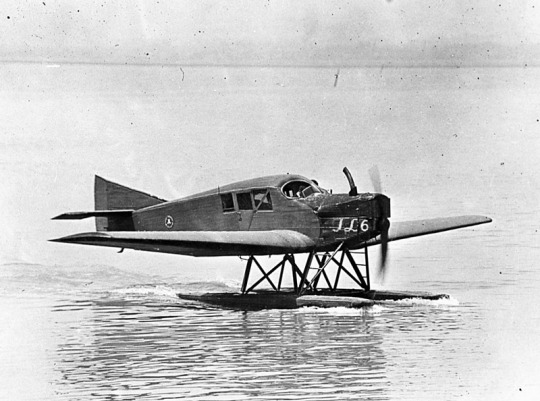
image: Joseph Eaton via US Navy National Museum of Naval Aviation This is actually the US license-built version, the Junkers-Larsen JL-6, but I couldn't find any pictures of actual J.13s on floats.
Unfortunately, Finnair was founded under the name 'Aero', which is probably the actual single worst name for an airline I have ever heard. We can jest and joke about things like Jet2 and Fly Air, but I sincerely do not think I have ever seen anything with worse SEO than an airline named 'Aero'. Even for 1923 this was fairly dire - back then, as for much of history, airlines were generally named for the area they served. Aero may have been a private company, rather than state-owned, but that didn't mean they couldn't name themselves for the area they served - private airlines have always done this and still do. Incredibly enough, there was a second 'Aero' founded in Poland in 1925, but that was quickly merged into what would become LOT Polish Airlines, shedding the name like a chrysalis.
Bafflingly, even when the Finnish government bought the airline in 1946 (they still own a majority share of it today) they didn't bother to change the name. They did begin writing 'Finnish Airlines[1]' on the fuselages, but as far as I can tell this appears to have been more of a stylistic flourish of sorts than an actual rebrand, or maybe even a clarifying subtitle on the very nonspecific name. In 1953 they began marketing under the much catchier 'Finnair', but the company remained legally named 'Aero' until literally 1968 and the fuselages still read 'Finnish Airlines'.

image: Finnair An Aero/Finnish Airlines Convair 340, photographed in 1953 in a livery which included both the large 'Finnish Airlines' wordmark and 'Aero' on the tail.
Early Finnair, like most early airlines, didn't have a particularly standardized livery for its fleet, and even where it did it's not very well documented. Finnair unfortunately has some of the poorest documentation for livery evolution of any large airline I've discussed so far, which really surprised me. That said, it's when the name became Finnair that things begin to be easier to find, and so that's where I'll begin.
1968: CLASSIC FINNAIR

This original logo[2], introduced in 1968, was designed by Kyösti Varis - at least, that's what every logo database I looked in said. I actually couldn't find either Finnair or Varis confirming this[3], but I still think it's probably true. Unlike designers like Vic Warren and Lindon Leader, who wrote and gave interviews about their designs for major airlines, Varis appears to have other preoccupations. He is enormously successful and prolific, to the point where his website doesn't even mention Finnair. According to the timeline he provides he would have either been creating this logo freelance or in his very last days at Advertising Agency SEK (probably the latter, since they did the two subsequent iterations), and based on his history as a typographer I think it's safe to say the letterforms are his creation as well. Also according to his timeline, he is younger than Finnair! And we almost have the same birthday.
I like the original Finnair branding. It's not ostentatious, but it's nice and sleek, with that forward slant I love in airline branding and a long unbroken line (both in the 'F' logo and in the even heights of the letters in the wordmark). It looks aerodynamic and the rounded, blocky letters have a hint of that 60s futurism while not being gimmicky. It's kind of incredible looking at it next to the '91-'94 FedEx wordmark, which occupies the opposite end of the sliding quality scale of TRON-looking text. The design as a whole is simple enough to easily reproduce but distinct enough to easily recognize. The shade of blue chosen is a fair bit lighter than the blue of the Finnish flag, but visually pleasing enough. They basically keep iterating on this general concept for the rest of their history, which I think is fantastic - no need to get rid of something that's working for you. It's nice to see an airline not feel pressured to reinvent its logo and livery every 20 years. That's about it for the logo[4] - what about the livery?
As mentioned prior, Finnair's liveries, before quite recently, were very poorly documented. Variants definitely existed between different types and different periods in the company's history, but the broad strokes of the branding seem to have remained almost startlingly intact for around thirty years.
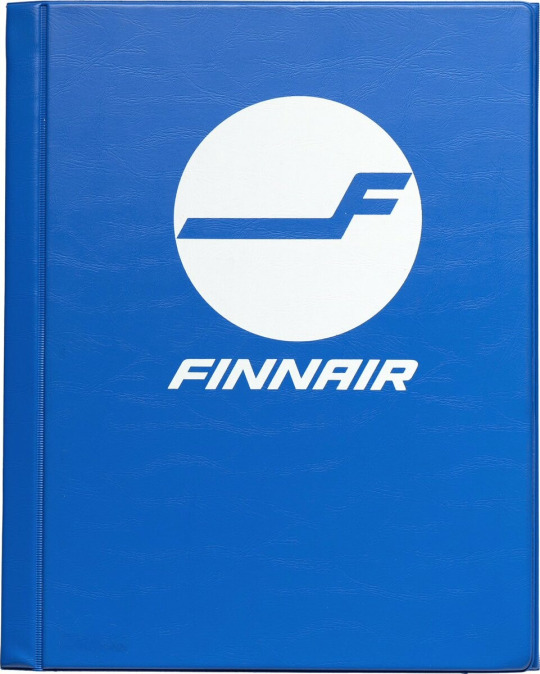
image: Letterform Archive The cover of a style guide from 1985. If it's changed from the 1968 original, I can't tell how.
But I'm really here to talk about one thing: the liveries.
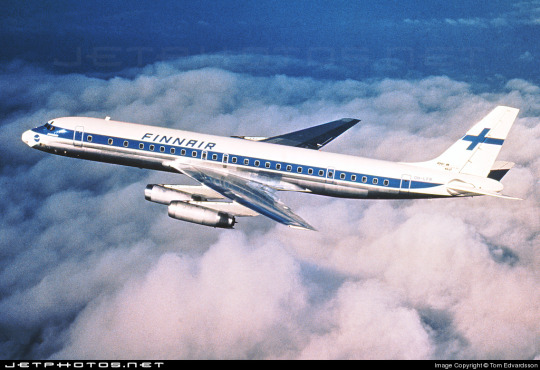
The above image was from Finnair's own archive and was taken in 1968[5], making it contemporary with the introduction of the Kyösti Varis branding, as well as lining it up with the 1969 addition of DC-8s, like the pictured airframe.
For the majority of Finnair's history, their livery is always going to look something a little bit like this. Primarily white, with a thick blue cheatline (in what I call the domino-mask style, where it's vertically centered around the cockpit windows) that lightly flips up at the very end and a blue cross on the tail to represent the Finnish flag.
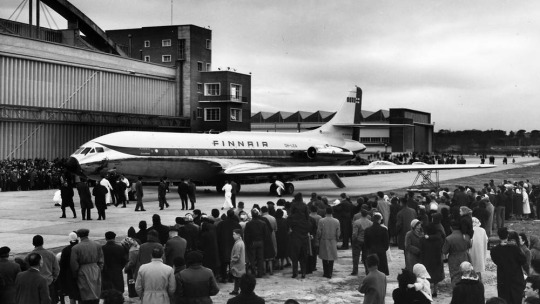
Finnair says this image is from 1960. If so, the livery was already well on its way to existing prior to 1968, with my guess being that it was introduced in 1960, along with the first jets in Finnair's fleet - the pictured Sud Aviation Caravelle, which pioneered the swept-wing, aft-engine format later seen on immensely popular jets like the DC-9 and Tu-134 - the latter of which was commissioned specifically because Nikita Khrushchev was so impressed with the Caravelle's aft engines and the quiet cabin experience they provided. It's a plane with a lot of unique visual features, featuring a nose that looks almost slanted downwards (a copy of the de Havilland Comet nose), a cruciform tail (instead of the more efficient T-tail used for future rear-engined designs), and triangular passenger windows. Most crucially, though, it was more or less the first short-range jet on the market. This made it perfect for an airline like Finnair, which at this point didn't really go that far from actual Finland.
This 1960 photograph provides a very strong blueprint for what was to come. It's the first iteration of the livery to say 'Finnair' instead of 'Finnish Airlines', and it's introduced a modern-for-1960 single-rule cheatline, although this early version was flipped horizontally, curling up at the front to frame the cockpit windows instead. (I think the white paint also cuts off behind it, leaving the space in-between the cheatline and painted nose blank metal, but in black-and-white it's somewhat hard to tell.) I do think I prefer the modern version. The use of the white downward curve with no blue hemming it in creates a really nice effect where it blends with the unpainted metal underside, due to the metal being right where you would expect to see a shadow anyway. (This effect is why I'm not quite sure where the paint ends on the Caravelle, and am just guessing based on which parts are noticeably reflective.) I definitely prefer the change made to the tail, where the single line of trim at the end of the rudder was replaced with a white canvas for the Finnish flag.

While I do tend to have a slightly pessimistic outlook on primarily-white liveries, I will say that if you're going to have a primarily white plane, and you are the flag carrier of Finland, this is a fairly understated and stylish way of incorporating it. While I probably would have done it on the main body, over where the first set of doors is, instead of on the tail, I think this is far from the end of the world. What they have is a nice, elegant taper where the tip seems to point directly at the tailplane, and it looks neat and intentional. A lot of airlines tend to just awkwardly slap a logo on their tail, which often looks really sloppy due to poor alignment or even just out-of-place entirely, and Finnair avoids that while keeping the tail from being completely blank. Having an element on the tail that's more horizontal than vertical, like the old 'AERO' rectangle or the tail rectangle on the one decent livery Lufthansa ever had.
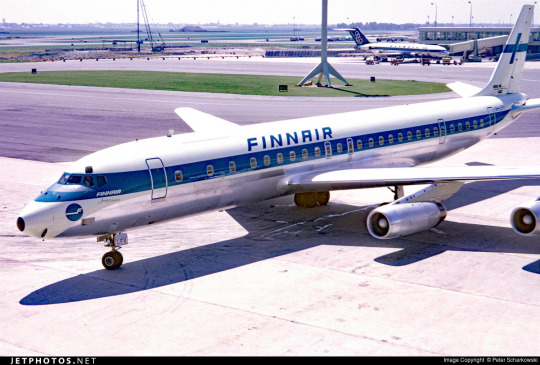
If you look in the background, you can see that wow has the Olympic Air livery looked like that for a long time! But that's a story for soon.
Additionally, some details were added on the nose. You can see on this DC-8, photographed in 1969, that the nose features an e-girl cheek stamp of the Kyösti Varis logo. Next to it is the name of the aircraft - in this case, Jean Sibelius - in really difficult-to-read thin text. (Finnair unfortunately appears to have stopped naming their planes by the late 1970s, but at one point they would frequently be named for Finnish people and places.) The 'domino mask' goes quite a bit beyond the cockpit windows to create a wider line from the side. I wish that the logo could have been integrated some other way, because the extra little blue thing just looks cluttered, but I can't imagine how they would do it without just replacing the cheatline. I mean, that would have been an option - indeed, it's what I would have done[6] - but assuming that they keep this general look I think the logo just can't fit in on the livery. The engine nacelles, maybe? Though that would still present issues on the Caravelle, where the engines are directly over the cheatlines. I also wish they would have made it a bit easier read the name, because I like to know what the plane's name is - thankfully, some later paint jobs actually do this before, tragically, Finnair stops writing names on their planes at all.
I believe this to be the strongest iteration of the classic Finnair livery, and it was pretty obviously optimized for the DC-8. Modern airlines tend to not bother adjusting their liveries between types, creating some absolute travesties of proportion, but Finnair boldly went in the opposite direction by modifying it for each airframe and yet still having it look worse.
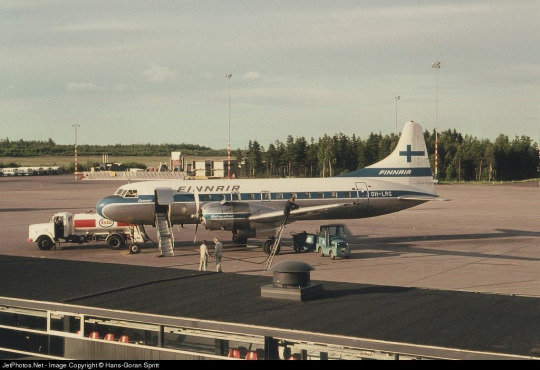
The sharpest deviation arises in the CV-440 version of the livery. This image is from 1971, just two years after the DC-8 liveries would have carried their first passengers, and it's wildly different. The cheatline is lowered sharply, sitting below the cockpit windows and wrapping around to contour the body of the airplane. There's a certain je ne sais quois to the domino mask that I find myself missing here. This design also has an unnecessary second 'Finnair' added to the tail, which kind of looks awkward stacked on top of the existing cheatline besides being redundant, and the Finnish flag on the tail is somewhat awkwardly made free-floating. It feels a lot less sleek and a lot more arbitrary.
On the other side of the plane the cheatline goes down quite a bit farther than on the jet models, probably because they thought it would be a better way of negotiating the Convair's rather bulbous nose, and I actually think I prefer the wide, upturned variant. This version, if anything, is too close for my taste to the livery VARIG operated in a similar timeframe. There are a lot of differences, yes, but in the 70s having one big solid cheatline on a white body and metal underbelly was the equivalent of the Lufthansa Line, so if you toed said line, be it cheat or Lufthansa, you risked becoming easily mistakeable for any airline with too similar of a color scheme. And blue-on-white was maybe the most common color-scheme at the time.
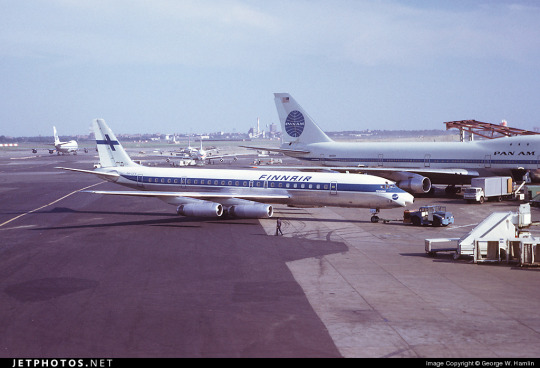
I doubt Finnair shared many tarmacs with VARIG, but here they are with Pan Am, and they could also expect to run into airlines like Sabena, Icelandair, and probably a half-dozen I've never heard of, all competing to be the one the others get mistaken for. It's a tricky position to be in.
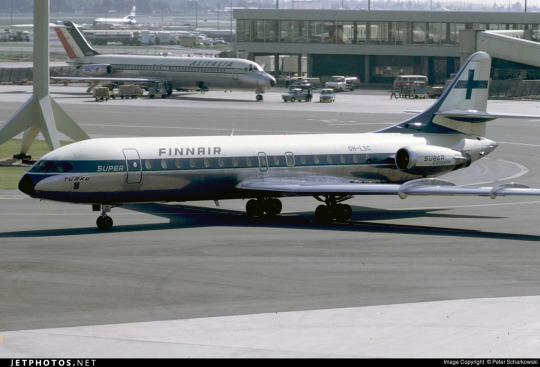
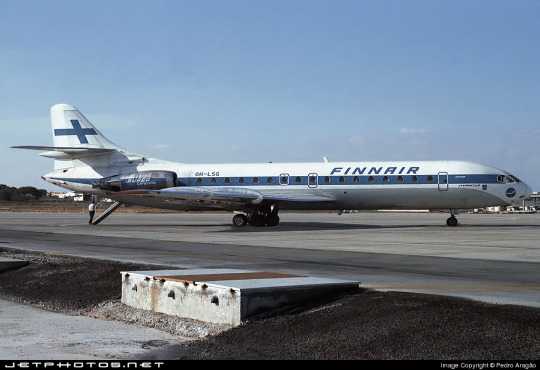
I do quite like the livery on the left, maybe even more than the DC-8 one, but I can't seem to find any other airframes painted like this. I'm not sure why this one is.
These images are from 1971 and 1969. They are both the same model of airplane - the Super Caravelle or Caravelle 10B. Their liveries are completely different. And that's just how it was back then - not even standard within the same airline, somehow still trying to stay distinct from dozens of other non-standardized blue-on-white cheatlines.
When evaluating classic Finnair, I have to keep myself tempered in both directions. When I think it's clean and well-proportioned I have to remind myself that it's just a complete nothingburger. When I think it's a lazy and cowardly non-design I have to remind myself that, no, at its best classic Finnair does look like it was designed with some thought, and it does have some traits that feel at the very least interesting enough to merit not being totally dismissed.
But...look, I have to give classic Finnair a D+. Because they tried, and they did something, sure, but it's ultimately not something especially memorable and the implementation is just spotty.

Even given a canvas like the DC-10, they fumbled. The DC-10, in my opinion, was a big test for them. And I do mean big. In the DC-10 is a plane with all the space in the world to add visual elements, and a space where just a couple lines can go from a detail to a fin that towers over anything that isn't a 747, showing off the Finnish flag as if someone had flown it from a building mast. The third engine, which I feel like a lot of airlines really struggle with on the DC-10, gets a nice horizontal line of writing that's not intrusive but helps prevent it from feeling like a giant gap. The wordmark gets larger, is moved forward, gets to really own the space it takes up instead of being squeezed in. And...they made the cheatline just....a really thin flat line that looks bad and stiff and boring. There's nothing setting them apart from Icelandair, and Icelandair's livery from this point in time was so boring that my only comment on it was that it looked like they forgot to paint the rest of the plane. You can do white planes well, but Finnair just really doesn't get there.
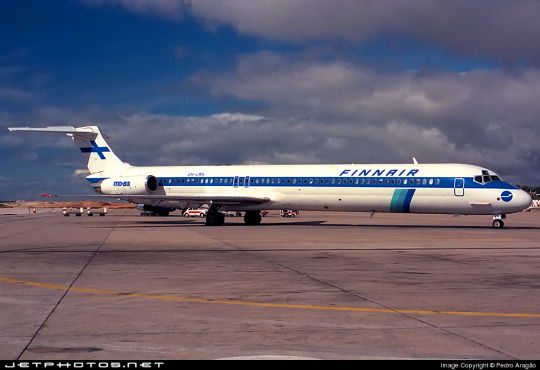
...hey, Finnair? You can't just decide to do belly stripes but worse, Finnair, you're literally next door to like two thirds of SAS and that livery was designed from the ground up. They have a couple of near-misses with SAS's toes but this is the one that makes me actually go 'is this allowed?'. It seems to have been exclusive to their late-80s MD-80 fleet, but it's just incredible to me that it ever happened. (That said, those three shades of blue are so nice together and I wish they had ever brought them back. I understand the appeal of sticking to the stark contrasted blue-on-white of the flag, but there's so much potential out there!)
1997: NEW TYPE, NEW LIVERY
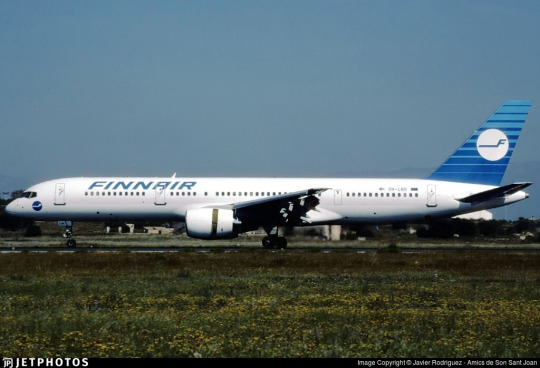
I really like the 757. It deserves a better livery than this.
Removing the cheatlines was a very trendy choice to make. This is the sad beast I call the Deltalite - a Deltalike but without the painted nacelles and belly that are usually slight redeeming factors. There's such a beautiful design on the tail that could have been put on the whole fuselage, honestly, and that's sad, but even on the most granular of levels...why keep the little cheek stamp if you have the logo visible on the tail now? Weird choice. Being so desperate to do the Deltalite thing everyone else is doing that you get rid of your country's flag on the tail is just a bad choice of priority, I think. There's not much to say about this. Honestly, I'd drop it to a D-. There's enough happening that it would lose something by being painted into Star Alliance colors, but it wouldn't lose terribly much.
2000: NEW FINNAIR

Oh, Finnair. Why? Did no airline resist the siren song of getting way too into airbrushing in the early 2000s?
Maybe I just have whatever the opposite of nostalgia is for the early 2000s, but this just makes me sad. They've made the wordmark look worse, overcomplicated the simplicity of the logo, and gone ham with the gaussian blur.

Look, it's not all that bad. The shades used on the actual plane are noticeably darker, and the colors at least don't look half bad now. And they've even bothered to paint the engines this time around! But...come on. You've changed 30 years of something that was working just fine for...this? Something which maybe climbs up to a flat D?
The 2000 brand overhaul, including the logo, was done by Finnish agency SEK & Grey. They're nearly as old as Finnair and have worked for brands as prominent as Coca-Cola and Kellogg's, but their about page puts Finnair front and center. They have an entire page describing their Finnair work.
Despite claiming to have included humanity and warmth and movement, I see none of this. I'll admit upfront I generally dislike what's dubbed 'Nordic' design. It's not the minimalism which I dislike but the banality.
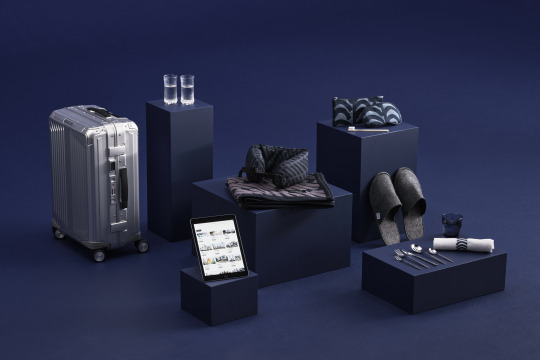
What does any of this have to do with Finnair? What here represents the history of one of the world's oldest airlines? What here really speaks to the Finnish people? Why is just designing something generic and making sure it's all crisp (when you're photographing it fresh out of the plastic, before it's been tripped over and stepped on and yanked down staircases and accidentally sat on and stained with tea) considered a substitute for designing something that people will see years down the line and get nostalgic for? I'm nostalgic as hell for Alitalia, an airline that doesn't exist anymore. I still use the bag from an amenity kit I got on Alitalia nearly ten years ago to store small essential things like toothbrushes and medication while traveling, but I wouldn't know it was Alitalia by looking at it, because it's lovely and convenient and ergonomic but it's literally just grey. It evokes nothing, and it doesn't even say 'Alitalia' on it anywhere. Nothing here could ever be considered ephemera or memorabilia. I could steal Finnair's look at the Gap.
2010: SORRY, HERE'S NEW FINNAIR FOR REAL THIS TIME

SEK & Grey gave it another shot. This one's a lot better.
I like the change in the logo, first off. And this, the word 'Finnair', is the logo, but I'm comparing it to the earlier wordmark. 2000's attempt felt like it was taking the original and just trying to sand off the corners to make it more modern, but the 2010 take on it actually shapes each glyph into a neat little space-age thing that creates this curved shape by way of a lot of straight lines, in a way that feels visually pleasing and interesting. I enjoy the square holes in the A and R, the return of the crossbar on the N, and the extreme range of widths which gives the letters a real weight to them. This isn't a typeface - these glyphs exist in the context of the word FINNAIR in this exact configuration and one of four colorways. Finnair does have a proprietary typeface, Finnair Sans, and it looks nothing like this because this is not a font, it's a logo.
I think it is a shame that this is the logo now. I really liked the F. And they haven't gotten rid of it, but it's now been relegated to an official subordinate position, according to their branding guide:
The official Finnair logo is the text version of the logo, and it is primarily used. The F emblem is used as an additional symbol.
Look, I'll always think it's a shame when your main logo is just the name of your company. Some airlines do it, and it feels like an empty space to me. It can be satisfactory but not outstanding. When you start out with a nice little symbol and then take it away, though, I do feel somewhat robbed.

It stings extra because I really like the way the new F looks. It has that long brushstrokey look and it almost makes me think of Hebrew characters. The way it tapers now really adds to the feeling of movement I get from it, and it's a great base for a livery. Now that it's darker, even though this does bring Finnair into competition with airlines like SAS, LOT, TAROM, Lufthansa, and even Ryanair when it comes to dark-blue-on-white, it also contrasts better with the main body, and it's still light enough that you can recognize it as blue. Anyway, it doesn't take a genius to know how to integrate this into a livery. Long line for the fuselage, go up to match the tail...
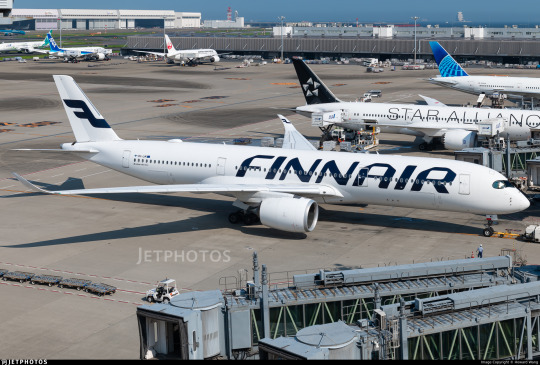
Finnair. Are you serious, Finnair?
Look! I get it! Billboards are in now, it's fine, I get it. it's probably the nicest billboard I've seen in a while, font-wise. It feels comfortable on the fuselage and it feels like it earns the space it occupies. The F is nicely centered on the tail, cuts off at a pleasant point. But...why?
I really can't be too mean about this. I want to be meaner than I actually can justify, because I think if any other airline made their plane this featureless I would hate it but Finnair's billboard livery is actually nice enough and everything is placed well enough that it's not at all unpleasant to look at. It's an acceptable livery. If maybe 25% less planes were basically all white it would shoot up in my esteem. I don't really like the fact that they put the little Fs on the inside of the wingtips of their A350s, but that's really my only nitpick. It's just sort of...bringing a really fantastic loaf of bread to a potluck when you were asked to bring baked desserts. You've done a very good job, but you didn't quite get the assignment.
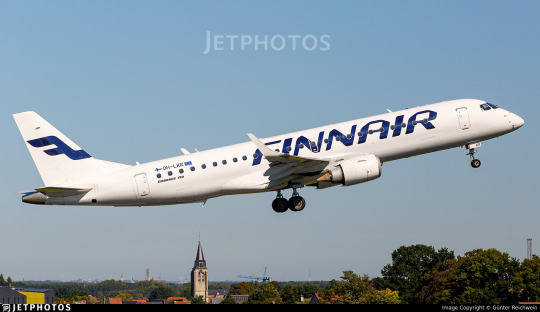
It's a bit hard to critique the modern Finnair livery in detail because I think it's executed fine. There's nothing really wrong with it except that it has a logo that could lend itself to all sorts of interesting shapes, it has 30 years of variants of a very specific design to draw on, and it's chosen to go tabula rasa just to be all clean and minimal instead of doing any of the interesting things it could have with this new start.
I want to dislike this take on the Finnair livery, but at the end of the day I just don't. I think it's completely satisfactory. A lot of airlines try to get this look and somehow end up seeming cluttered for it. Finnair is one of the only instances I can think of where a white fuselage with just a wordmark has looked okay. It isn't ugly. It hasn't failed at the thing it's trying to do, but I think that it should have tried to do something else.
At the same time, though, this is the most Finnair that Finnair has ever been. The blue cheatline and the Deltalites were stumbling over well-trod ground. The modern livery, at least, isn't sloppily tail-heavy and seemingly thoughtless.
I give modern Finnair a C. This took an excessive amount of deliberation, but it really is...good enough. It's satisfactory. It's fine! I would have taken a completely different direction, but they have done a good job with their sort of lackluster idea. It's alright. We'll check on them again in another hundred years and see where they're at.
2023: CENTENAIRY
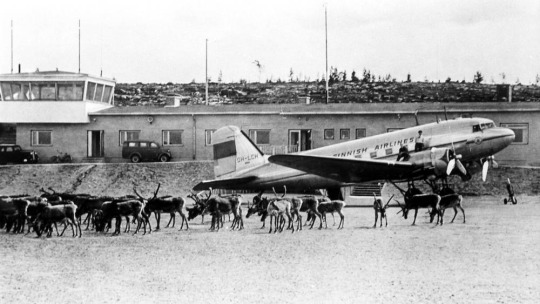
A century is a very long time. Finnair is older than my oldest grandparent. Finnair is older than over a dozen sovereign countries. Finnair is older than aerodromes in Finland. It's older than every currently operating airline except KLM, Avianca, Qantas, Aeroflot, and Czech Airlines. As of the first of November, Finnair is in triple digits.
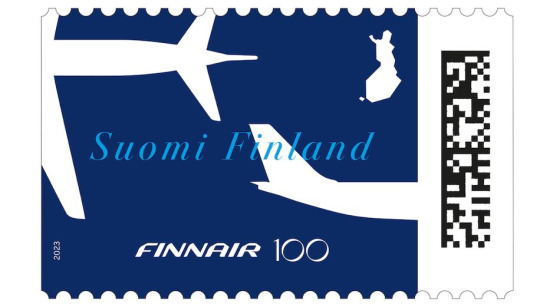
I adore this centenary stamp Finnair has put out, celebrating the long relationship between aviation and the mail. It's not complex, but it's not barren, either. It combines the dark blue of the modern livery with the light blue of the classic one, all with the white silhouettes of airplanes elegantly soaring over an outline of Finland. The outstretched white wings on the deep blue have the grace of a giant fish swimming beneath a glass-bottomed boat.
But of course it isn't just stamps. Finnair is an airline. Airlines do special liveries. Qantas and KLM both slapped a big 100 sticker on an airplane for their big anniversaries. Finnair has of course done something similar.

Three airframes - the pictured A350-900, OH-LWR, and two A320s - OH-LXK and OH-LXM - have had a 'bringing us together since 1923' sticker applied. Matching the rest of Finnair's branding, it's certainly quite minimal, but it's a nice gesture. It's not what people have been talking about. That's OH-LWO and OH-LWP, both A350-900s, who have been given something more substantial to wear.
youtube
I'm going to assume that after its renaissance on tumblr a few years back most people reading this are familiar with the Moomin franchise. I definitely am, because when I was in my larval stage my mother first taught me to read Russian using an omnibus book of Moomin stories. Creator Tove Jansson apparently designed both the shape of the eponymous white critters and the sound of the name Mumintrollen itself are designed to evoke a feeling of softness, and it's clear why these characters are so beloved.
It isn't the first time Finnair, which frequently collaborates with Finnish brands and highlights its Finnish roots, has featured Moomins.
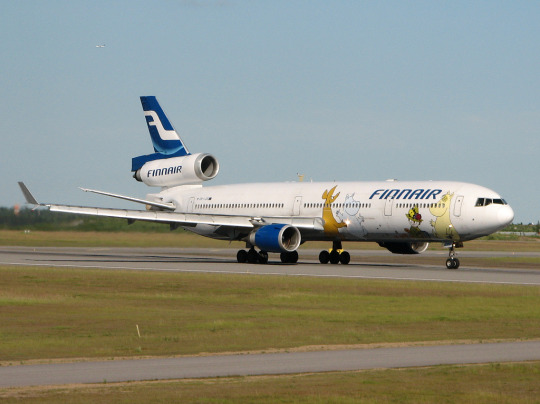
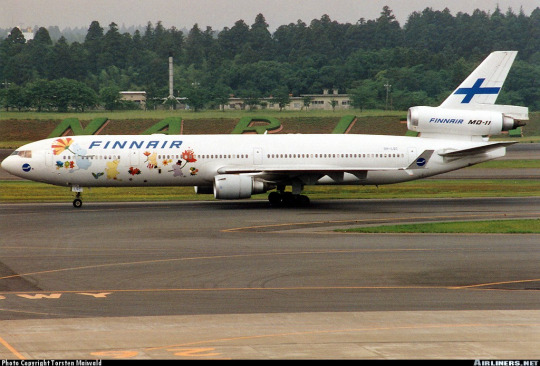
image on left: Antti Havukainen
In the 1990s, the airline first flew a Moomin jet. They had another in the 2000s. Both were withdrawn from service before 2010. It's been a while now since Finnair flew their last MD-11, but when celebrating their 100th birthday, a milestone that the vast majority of airlines will never see, they chose to do it by way of a soft Moomin embrace.
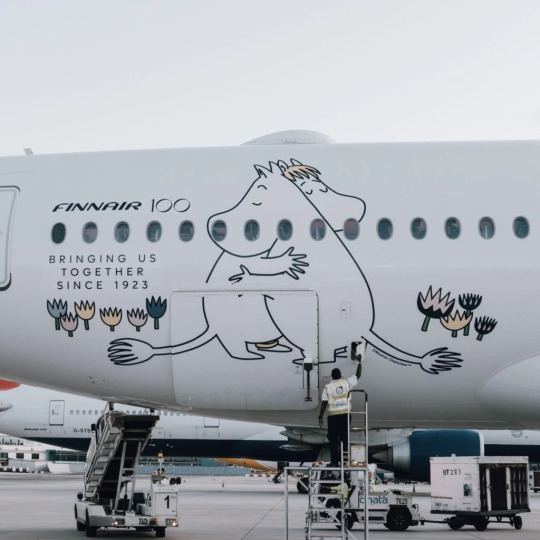
image: Changi Airport
And, I'll be honest, I think it's very sweet. It got an actual, sincere little smile out of me.
100 years is a really long time. In 1923 aviation was unrecognizable. What we would now consider an airliner didn't really exist yet - space for ten passengers, closed cockpits, and metal fuselages were the exceptions rather than the rule, and the Ford Trimotor was two years from its first flight. Cabin crew were barely even a concept. Airplanes, for all intents and purposes, were considered a type of boat. A nonstop flight across the Atlantic was a ridiculous concept. In a report published by the US National Bureau of Standards, it was said: 'there does not appear to be, at present, any prospect whatever that jet propulsion of the sort here considered will ever be of practical value, even for military purposes'. There were no aerodromes in Finland, so a small company called Aero attached floats to a plane just large enough for four passengers and took them from Helsinki to Tallinn.
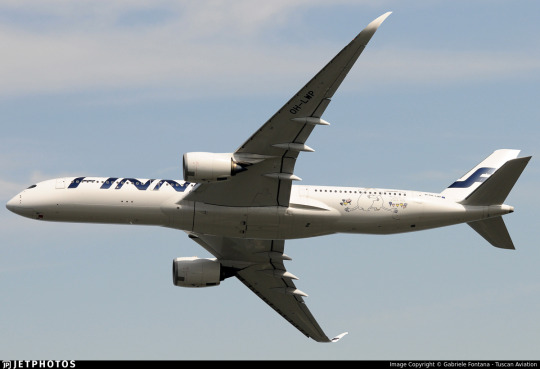
Look how far we've come.
Footnotes:
[1]: The Finnair website's history page, which I used as a source for much of the background and several images in this post, renders it as 'Finnish Air Lines', but on the airplanes themselves it clearly has no space, so I've corrected that seeming error for them. I don't know why this discrepancy exists, because as far as I know during this period they were marketing themselves as Aero so this text would only have existed on the livery itself. [2]: Actually, I very occasionally see this version where the F logo isn't fully surrounded by the circle and the F in the wordmark doesn't have the rounded top, and I don't know which came first or if the less round version is just somehow...not real? I did try to figure this out, I swear, but at some point I realized I am literally not a professional logo historian, and nobody is going to be let down if I don't brute-force an answer despite not even speaking Finnish, and I should finish writing the post before it's 2024. [3] The closest thing to an official source I can find is the descriptions of two listings for the centenary stamp including a quote from designer Ilkka Kärkkäinen attributing it to him. I don't at all doubt that he did design it, but I always like to find concrete attribution for things if I can and would hate to spread misinformation and the sparseness of confirmation here is something I find very strange. My best guess is that there's plenty of good sources on it in Finnish but nobody has bothered to make it as clear in English. [4] Admittedly this is a stretch, and I certainly don't think it was intentional, but it does remind me of the longship prow used in early SAS liveries. This motif was introduced in 1946 and continued to see use after the Finnair logo was introduced. The overlap is fairly limited in that SAS never used the longship in their logo (...I kind of want to talk about their logos one of these days) and the Finnair livery you'll see shortly doesn't look like SAS's at all, plus SAS has the extra pink on their liveries, but I couldn't get it out of my head that they do look sort of alike. [5] The absolute hero who uploaded it to jetphotos mentioned that Finnair had given him the photograph while planning to dispose of it, and this makes me wonder if the lack of documentation is just because Finnair doesn't hold onto their old materials, which makes me very sad. A lot of companies, more broadly, didn't bother to keep records until somewhat recently, but in Finnair's case it seems to be particularly egregious. As someone literally studying to be an archivist it makes me exceptionally sad to see history lost just because nobody cared enough to preserve it. [6] Maybe they didn't want to look like backwards SAS. Who can say?
#tarmac fashion week#finnair#grade: c#grade: d+#region: finland#grade: d#grade: d-#region: northern europe#era: 1960s#era: 1970s#era: 1980s#era: 1990s#era: 2000s#era: 2010s#era: 2020s#special liveries#commemorative liveries#requests
50 notes
·
View notes
Text

Porte-avions USS Saratoga (CV-3) en cale sèche – 1928
©United States Navy National Museum of Naval Aviation - 1989.119.002
#WWII#ww2#avant-guerre#pre war#marine américaine#us navy#marine militaire#military navy#porte-avions#arircraft carrier#classe lexington#lexington-class#uss saratoga (cv-3)#uss saratoga#cv-3#1928
27 notes
·
View notes